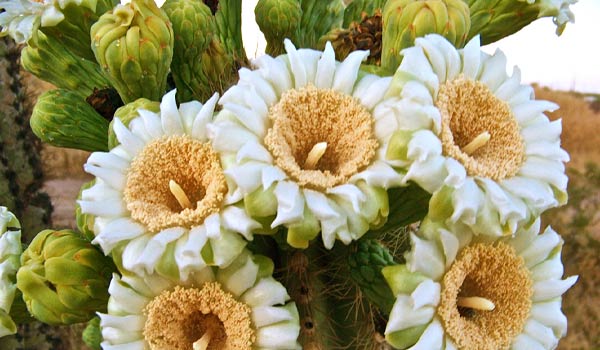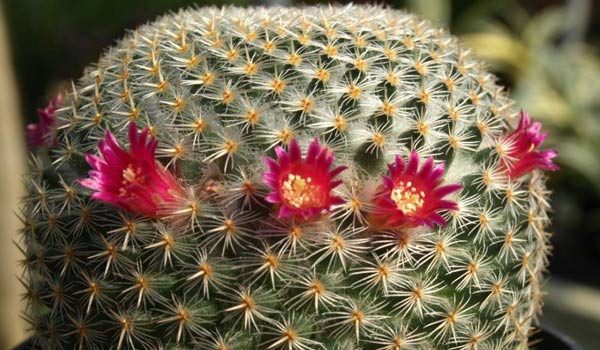Cactus Flowers Names & Anatomy

Cacti can be quite exotic, eye-catching, and vibrant on their own. But they don’t stop there. Cactus flowers are also there to add a dash of color. All cacti are flowering plants, and their blooms vary in color and shape. Not all cactus flowers are equal, as some are unbelievably prominent and gorgeous, like Mammillaria, Gymnocalycium, and Parodia.
In this post, we are going to talk about cactus flowers, their names, anatomy, and that how you can help your cacti bloom regularly like any other houseplant. To cover the last part, we’ll talk about barrel cactus flower and the conditions it requires to bloom. It is a popular cactus, and its blooms can make everyone forget about the many spines that it has.
But before that, let’s know more about cactus flowers, their names, and shapes.

Cactus Flowers Anatomy
Spines are not the only variable part in cacti; the flowers are also variable. As a whole, cactus flowers are usually radially symmetrical. They also may be bilaterally symmetrical (zygomorphic). Cacti bloom colors mainly range from white to yellow and red to magenta.
In many cactus blossoms, the material derived from stem or receptacle tissue surrounds the ovary and forms a structure known as the pericarpel. What continues this structure, is the tissue from the petals and sepals. Together, they form the composite tube. You can call this whole in cactus flowers the floral tube. But if we are to be quite precise, actually only the furthest part from the base is floral in origin.
On the outside of the floral tube in cactus flowers, you can see the areoles which produce wool and spines. This tube generally has small scale-like bracts the gradually turn into sepal-like and then petal-like structures. As a result, we will not be able to distinguish sepals and petals easily; and the solution is to call them “tepals”!
However, in some cactus blooms such as the Gymnocalycium, the floral tubes have no wool or spines. In some other varieties like the Mammillaria, the tube is completely devoid of any external structures. This is while Pereskia flowers may be borne in clusters, unlike most of the other cactus flowers.
Another common feature in most of the cactus blooms is their many stamens. They have different styles in different cacti and may branch at the end into more than a stigma. Generally, the stamens appear from the inner surface of the upper part of the floral tube. But in some cactus flowers, they arise in one or more series in more specific areas of the tube structure’s inside.

Famous Cactus Flowers Names & Types
As mentioned above, cactus family (Cactaceae) members are flowering plants that are known because of the many stamens in their centers. There are more than 1,000 different species of cacti, ranging from small groundcover-like clumps to tree-like ones. And here are the most known cactus flowers you need to know:
Prickly Pears
Prickly pear blooms inherit their name because of their edible fruits. They belong to the botanical genus Opuntia that has showy yellow flowers. In some species, the cactus flowers can be white, pink, orange, or red as well.
If you grow one of these cacti and you want to taste the fruits, when they ripen, carefully pluck them from the prickly padded stems (leaves).
Echinopsis
Among cactus flowers, Echinopsis has a notable diversity among almost 100 species. Commonly found in the arid part of South America, they resemble a trumpet and have an ornamental flare.
Saguaro
Saguaro (Carnegiea gigantea) cactus flowers appear in late spring to early summer, and you can only find them in the Sonoran Desert in nature. These white flowers open at night and attract nectar-seeking and pollinating doves, and close by noon the following day.
These blooms don’t all open at once; a few of them open each night over several days. The flowers turn into fleshy fruits later, and each fruit contains more than 4,000 seeds.
Cereus
Members of the Cereus, Hylocereus, and Peniocereus genus are known as night-blooming cereus or queen of the night. Their white cactus flowers have long stems that ramble over trees or rocks, open in total darkness, and close by dawn. Plants in the genus Epiphyllum are similar to these blossoms, but they don’t just open at night.
Pereskia
Pereskia blooms resemble roses or camellias and make the shrub lovelier. The Pereskia Grandiflora produces pink flowers, and the Pereskia bleo produces orange ones.

Encouraging Cactus Flower
As a rule, cacti and succulents bloom on fresh growth. So if you have a cactus that doesn’t bloom year after year, there’s a problem. To resolve the matter, you need to help your plant follow its natural growth cycle.
To do this, you need to place it in a cold and dry spot in winter to go dormant, and stop watering. And in the spring when it’s going to wake up, provide it with as much sunshine as possible and water it like before. For example, this is how you encourage barrel cactus flowers.
Barrel Cactus Flower
Similar to many other cacti, Barrel cacti flower during the spring and summer, between April and September. Long daylight hours in this period stimulate the cactus’s growth and reproduction.
In the fall and winter months, the barrel cactus go dormant and its growth stops until spring and its long daylight hours come back again. To help barrel cactus flower, keep an eye for these requirements:
Water
Although Cacti are resistant to drought; but you can except barrel cactus flower from a shriveled up plant. Cacti need a lot of energy to produce healthy and vibrant blooms. If your barrel cactus receive the needed and normal amount of water, it should be able to bloom in spring and summer.
Light
Too much or too little sunlight affect the barrel cactus flower greatly. You need to provide your cactus with full sunlight during the spring and summer to be able to enjoy gorgeous its blooms. If the plant is not properly acclimated to sunny areas, the blooming can be stunted as well.
When growing the barrel cactus outdoors, it may not be able to produce flowers after shady winters (because of sunburns across its body). You need to slowly introduce your plant into the sunlight.
Barrel cactus flower is also unlikely when it is in the shade throughout the entire year. In such a situation, you won’t get anything more than buds that don’t open.
Soil
Cacti are not very picky about their soil. But they won’t be happy in a potting mix that isn’t well-drained and rich. Such soil is also necessary for Barrel cactus flowers. During the growing months, you can also feed your plant with a higher phosphorus fertilizer (we recommend 5-10-5) for spectacular blooms and better stem growth.
After making sure about providing the soil nutrients, remember to avoid overwatering. Your plant can’t live for very long in wet and soggy soils.
- In this post:
- Cactus Flowers Anatomy
- Famous Cactus Flowers Names & Types
- Encouraging Cactus Flower



